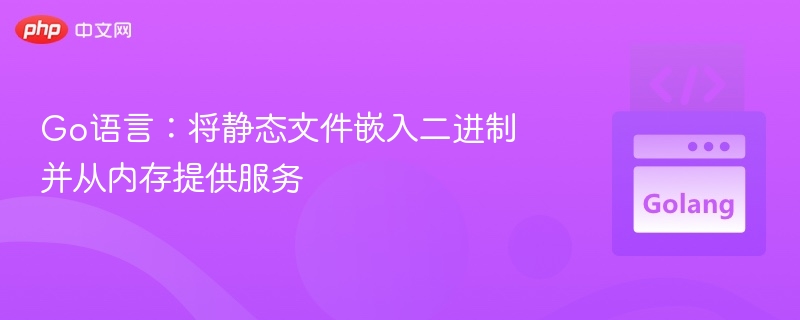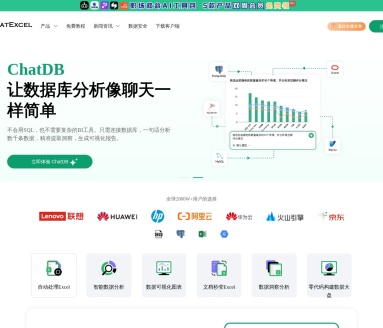返回自身方法提升代码可读性与灵活性
Go语言中,方法返回接收者自身的设计模式,常见于链式调用,但更重要的作用在于访问匿名结构体字段。本文聚焦后者,通过分析`go/token`包和`go/ast`包中的`Position`类型及其`Pos()`方法,深入剖析这种设计模式的必要性。当结构体嵌入匿名字段时,虽然其方法集会被提升,但直接访问该匿名字段本身却受限。`Pos()`方法正是解决此问题的关键,它允许开发者通过`comment.Pos()`的方式获取`Comment`结构体中匿名`token.Position`字段的值。理解此机制有助于更高效地使用Go语言标准库,并在实际项目中编写出更具可读性和可维护性的代码,避免过度使用匿名结构体字段,提升代码质量。

Go语言中方法返回接收者自身的原因,通常是为了方便链式调用或者访问匿名结构体字段。本文将重点讲解后者,通过分析go/token包和go/ast包中的相关代码,深入理解这种设计模式。
在Go语言中,结构体可以包含匿名(或称为嵌入)字段。这些字段没有显式的名称,但其类型的方法集会被提升到外层结构体。然而,直接访问匿名结构体字段本身,在某些情况下需要借助特定的方法。
我们先来看go/token包中的Position类型和Pos()方法:
// Token source positions are represented by a Position value.
// A Position is valid if the line number is > 0.
//
type Position struct {
Filename string // filename, if any
Offset int // byte offset, starting at 0
Line int // line number, starting at 1
Column int // column number, starting at 1 (character count)
}
// Pos is an accessor method for anonymous Position fields.
// It returns its receiver.
//
func (pos *Position) Pos() Position { return *pos }Pos()方法简单地返回了Position类型的接收者自身。 那么,这个方法有什么用呢? 答案在于访问匿名结构体字段。
考虑go/ast包中的Comment类型:
// Comments
// A Comment node represents a single //-style or /*-style comment.
type Comment struct {
token.Position // beginning position of the comment
Text []byte // comment text (excluding '\n' for //-style comments)
}在这里,token.Position是一个匿名结构体字段。这意味着Comment类型继承了token.Position类型的方法,但token.Position本身并没有一个字段名。因此,我们不能直接通过comment.token.Position来访问它。
为了访问这个匿名字段,我们可以使用Pos()方法:
package main
import (
"fmt"
"go/ast"
"go/token"
)
func main() {
comment := ast.Comment{
Text: []byte("// This is a comment"),
}
// Create a token.Position and assign values. Normally this would be populated
// by the parser.
pos := token.Position{
Filename: "example.go",
Offset: 0,
Line: 1,
Column: 1,
}
// We need to set the Position value in the comment struct using reflection
// because it's an anonymous field and not directly settable.
// This is just for demonstration purposes. Normally the parser would
// populate this value.
//
// This is more complex than is reasonable for this example, but it does
// demonstrate the anonymous field functionality of the Pos() method.
//
// NOTE: This is not a good way to set the anonymous field. It's just
// a way to demonstrate the anonymous field access.
//
// A better way to set the anonymous field would be to use the ast.NewComment()
// function and then set the Pos field directly. However, that would not
// demonstrate the anonymous field access.
//
// The reflection approach is used here to demonstrate the anonymous field access.
//
// A real parser would populate the Position field directly.
//
// You should never do this in production code.
//
// Use the ast.NewComment() function and then set the Pos field directly.
//
// Or, if you are using the parser, it will populate the Position field for you.
//
// This example is just to demonstrate the anonymous field access.
//
// You have been warned.
//
// The following code is a terrible hack.
//
// I repeat, do not do this in production code.
// Get the type of the token.Position field.
posType := reflect.TypeOf(token.Position{})
// Get the value of the comment struct.
commentValue := reflect.ValueOf(&comment).Elem()
// Get the field of the comment struct that is of type token.Position.
posFieldValue := commentValue.Field(0)
// Check that the field is of the correct type.
if posFieldValue.Type() != posType {
panic(fmt.Sprintf("Expected field of type %s, got %s", posType, posFieldValue.Type()))
}
// Check that the field is addressable.
if !posFieldValue.CanSet() {
panic("Field is not addressable")
}
// Set the value of the field.
posFieldValue.Set(reflect.ValueOf(pos))
// Now we can access the position using the Pos() method.
commentPosition := comment.Pos()
fmt.Printf("Comment position: %+v\n", commentPosition)
}
上述代码演示了如何通过Pos()方法获取Comment结构体中匿名token.Position字段的值。 comment.Pos() 返回的是一个 token.Position 类型的结构体,包含了注释的位置信息。
总结与注意事项
- 当结构体包含匿名结构体字段时,该匿名结构体的方法会被提升到外层结构体。
- 如果需要直接访问匿名结构体字段本身,可以使用返回接收者自身的方法(如Pos())。
- 这种方法通常用于访问和操作匿名结构体字段的属性。
- 在实际开发中,应尽量避免过度使用匿名结构体字段,以提高代码的可读性和可维护性。
理解并掌握这种技巧,能够帮助你更好地理解和使用Go语言标准库,并在自己的项目中编写更简洁、高效的代码。
文中关于的知识介绍,希望对你的学习有所帮助!若是受益匪浅,那就动动鼠标收藏这篇《返回自身方法提升代码可读性与灵活性》文章吧,也可关注golang学习网公众号了解相关技术文章。
 Golang路径操作技巧与跨平台解决方案
Golang路径操作技巧与跨平台解决方案
- 上一篇
- Golang路径操作技巧与跨平台解决方案

- 下一篇
- Golang如何实现高并发Web服务?net/http并发机制详解
-

- Golang · Go教程 | 5分钟前 |
- Go语言嵌入静态文件及内存服务方法
- 198浏览 收藏
-

- Golang · Go教程 | 9分钟前 |
- Golang模板方法模式实例详解
- 237浏览 收藏
-

- Golang · Go教程 | 11分钟前 |
- Golang模块缓存优化技巧与加速方法
- 214浏览 收藏
-

- Golang · Go教程 | 40分钟前 |
- Golang装饰器模式怎么实现?
- 464浏览 收藏
-

- Golang · Go教程 | 52分钟前 |
- Golang工具更新与环境配置指南
- 379浏览 收藏
-

- Golang · Go教程 | 56分钟前 |
- Golang反射获取结构体方法技巧分享
- 483浏览 收藏
-

- Golang · Go教程 | 1小时前 |
- Golang自动邮件提醒设置教程
- 195浏览 收藏
-

- Golang · Go教程 | 1小时前 |
- Golangviper加载环境变量技巧分享
- 464浏览 收藏
-

- Golang · Go教程 | 1小时前 | golang 构建 依赖管理 gomodvendor vendor目录
- Golangvendor目录使用详解
- 374浏览 收藏
-

- Golang · Go教程 | 1小时前 |
- Golang发送GET请求的正确方法
- 258浏览 收藏
-

- Golang · Go教程 | 1小时前 |
- Golang协程管理技巧与生命周期优化
- 399浏览 收藏
-

- 前端进阶之JavaScript设计模式
- 设计模式是开发人员在软件开发过程中面临一般问题时的解决方案,代表了最佳的实践。本课程的主打内容包括JS常见设计模式以及具体应用场景,打造一站式知识长龙服务,适合有JS基础的同学学习。
- 543次学习
-

- GO语言核心编程课程
- 本课程采用真实案例,全面具体可落地,从理论到实践,一步一步将GO核心编程技术、编程思想、底层实现融会贯通,使学习者贴近时代脉搏,做IT互联网时代的弄潮儿。
- 516次学习
-

- 简单聊聊mysql8与网络通信
- 如有问题加微信:Le-studyg;在课程中,我们将首先介绍MySQL8的新特性,包括性能优化、安全增强、新数据类型等,帮助学生快速熟悉MySQL8的最新功能。接着,我们将深入解析MySQL的网络通信机制,包括协议、连接管理、数据传输等,让
- 500次学习
-

- JavaScript正则表达式基础与实战
- 在任何一门编程语言中,正则表达式,都是一项重要的知识,它提供了高效的字符串匹配与捕获机制,可以极大的简化程序设计。
- 487次学习
-

- 从零制作响应式网站—Grid布局
- 本系列教程将展示从零制作一个假想的网络科技公司官网,分为导航,轮播,关于我们,成功案例,服务流程,团队介绍,数据部分,公司动态,底部信息等内容区块。网站整体采用CSSGrid布局,支持响应式,有流畅过渡和展现动画。
- 485次学习
-

- ChatExcel酷表
- ChatExcel酷表是由北京大学团队打造的Excel聊天机器人,用自然语言操控表格,简化数据处理,告别繁琐操作,提升工作效率!适用于学生、上班族及政府人员。
- 3182次使用
-

- Any绘本
- 探索Any绘本(anypicturebook.com/zh),一款开源免费的AI绘本创作工具,基于Google Gemini与Flux AI模型,让您轻松创作个性化绘本。适用于家庭、教育、创作等多种场景,零门槛,高自由度,技术透明,本地可控。
- 3393次使用
-

- 可赞AI
- 可赞AI,AI驱动的办公可视化智能工具,助您轻松实现文本与可视化元素高效转化。无论是智能文档生成、多格式文本解析,还是一键生成专业图表、脑图、知识卡片,可赞AI都能让信息处理更清晰高效。覆盖数据汇报、会议纪要、内容营销等全场景,大幅提升办公效率,降低专业门槛,是您提升工作效率的得力助手。
- 3425次使用
-

- 星月写作
- 星月写作是国内首款聚焦中文网络小说创作的AI辅助工具,解决网文作者从构思到变现的全流程痛点。AI扫榜、专属模板、全链路适配,助力新人快速上手,资深作者效率倍增。
- 4530次使用
-

- MagicLight
- MagicLight.ai是全球首款叙事驱动型AI动画视频创作平台,专注于解决从故事想法到完整动画的全流程痛点。它通过自研AI模型,保障角色、风格、场景高度一致性,让零动画经验者也能高效产出专业级叙事内容。广泛适用于独立创作者、动画工作室、教育机构及企业营销,助您轻松实现创意落地与商业化。
- 3802次使用
-
- Golangmap实践及实现原理解析
- 2022-12-28 505浏览
-
- go和golang的区别解析:帮你选择合适的编程语言
- 2023-12-29 503浏览
-
- 试了下Golang实现try catch的方法
- 2022-12-27 502浏览
-
- 如何在go语言中实现高并发的服务器架构
- 2023-08-27 502浏览
-
- 提升工作效率的Go语言项目开发经验分享
- 2023-11-03 502浏览




